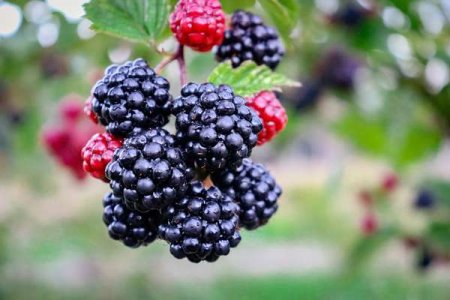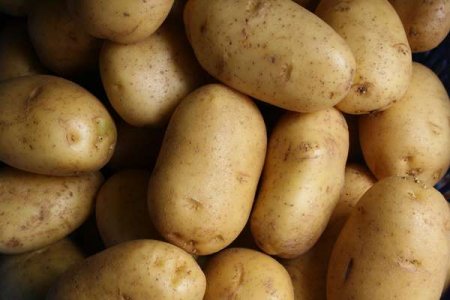Think these are clean? Two pantry favorites just made the Dirty Dozen list
- Replies 0
If you’re like most at The GrayVine, you take pride in stocking your kitchen with wholesome, nutritious food.
Maybe you even have a little extra spring in your step when you reach for a bowl of fresh fruit or a hearty baked potato, knowing you’re making a healthy choice.
But what if we told you that two of these “good-for-you” staples—blackberries and potatoes—have just been added to the Environmental Working Group’s (EWG) infamous “dirty dozen” list for 2025? Yes, you read that right. These pantry regulars, long considered the darlings of the produce aisle, are now under scrutiny for possible pesticide contamination.
The Dirty Dozen: What Is It, and Why Does It Matter?
Every year, the EWG releases its Shopper’s Guide to Pesticides in Produce, a report that analyzes data from the US Department of Agriculture (USDA) on pesticide residues found on fruits and vegetables.
The “dirty dozen” list highlights the 12 types of produce with the highest levels of pesticide contamination, even after washing, scrubbing, or peeling.
This year, blackberries and potatoes made their debut on the list, joining the ranks of spinach, strawberries, kale, grapes, peaches, cherries, nectarines, pears, apples, and blueberries.
Why the Sudden Spotlight on Blackberries and Potatoes?
The EWG’s decision to add blackberries and potatoes wasn’t made lightly.

For the first time, the USDA tested blackberries for pesticide residues, and the results were eye-opening: 93% of conventional blackberry samples contained pesticide residues, with an average of four different pesticides per sample.
One of the most concerning chemicals found was cypermethrin, a possible human carcinogen according to the Environmental Protection Agency (EPA), detected on over half of the samples.
Potatoes, meanwhile, have long been a staple in American kitchens. But new USDA data revealed that 90% of potato samples contained chlorpropham, a chemical used to prevent sprouting after harvest.
The European Union banned chlorpropham in 2019 due to health concerns, but it’s still widely used in the US.
Also read: Triple the life of your produce with this simple post-supermarket trick you need to try!
In total, more than 50 different pesticides were found on samples from each of the dirty dozen fruits and vegetables (except cherries), and most had an average of four or more pesticides per sample.
The Other Side of the Story: Are We Overreacting?
Not everyone is convinced that the EWG’s list should send us running from the produce aisle.
The International Fresh Produce Association (IFPA) and other critics argue that these reports can do more harm than good by discouraging people from eating fruits and vegetables at all—a real concern, given that 90% of Americans already fall short of the recommended daily intake.
The IFPA points out that the USDA’s own data shows that produce sold in the US consistently meets or exceeds the EPA’s strict safety standards.

They argue that the benefits of eating more fruits and vegetables far outweigh the potential risks from pesticide residues, especially when most Americans are eating too many ultra-processed foods and not enough fresh produce.
Harvard University has also weighed in, warning that not eating enough fruits and vegetables can increase your risk for diabetes, heart disease, certain cancers, and nutritional deficiencies.
The Clean 15: The Safer Side of the Produce Aisle
If you’re looking to minimize your exposure to pesticides without giving up on fresh produce, the EWG also publishes a “clean 15” list—fruits and vegetables that tend to have the lowest levels of pesticide residues. This year’s cleanest picks include:
- Pineapples
- Sweet corn (fresh and frozen)
- Avocados
- Papayas
- Onions
- Sweet peas (frozen)
- Asparagus
- Cabbage
- Watermelon
- Cauliflower
- Bananas
- Mangoes
- Carrots
- Mushrooms
- Kiwi
These are great options if you want to prioritize organic purchases or simply feel more confident about what’s on your plate.
Also read: Fresh food shouldn’t be a luxury: How one program is helping seniors eat healthier
Practical Tips: How to Eat Safely and Smartly
So, what’s a health-conscious shopper to do? Here are some tips to help you enjoy your favorite fruits and veggies while minimizing your risk:
1. Wash Thoroughly: The EWG recommends washing produce under running water for at least 20 seconds, using your hands to rub or scrub the surface. Skip the soaps, detergents, and commercial produce washes—there’s no evidence they’re more effective or safe.
2. Peel or Scrub: For items like potatoes, scrubbing with a brush or peeling the skin can help reduce pesticide residues.
3. Buy Organic When Possible: If you’re concerned about pesticides, consider buying organic versions of the dirty dozen, especially if you eat them frequently or serve them to children or pregnant women.
4. Mix It Up: Vary your produce choices to reduce repeated exposure to the same pesticides.
5. Don’t Skip the Veggies: Remember, the health benefits of eating a wide variety of fruits and vegetables far outweigh the potential risks from pesticide residues. Don’t let fear keep you from filling your plate with colorful, nutrient-rich foods.
Read next: Are you eating enough fruit to stay young? Dietitian reveals the surprising answer

What do you think about the dirty dozen list? Have you changed your shopping habits because of it? Do you have any favorite tips for cleaning or preparing produce? We’d love to hear your thoughts, experiences, and questions in the comments below!
Maybe you even have a little extra spring in your step when you reach for a bowl of fresh fruit or a hearty baked potato, knowing you’re making a healthy choice.
But what if we told you that two of these “good-for-you” staples—blackberries and potatoes—have just been added to the Environmental Working Group’s (EWG) infamous “dirty dozen” list for 2025? Yes, you read that right. These pantry regulars, long considered the darlings of the produce aisle, are now under scrutiny for possible pesticide contamination.
The Dirty Dozen: What Is It, and Why Does It Matter?
Every year, the EWG releases its Shopper’s Guide to Pesticides in Produce, a report that analyzes data from the US Department of Agriculture (USDA) on pesticide residues found on fruits and vegetables.
The “dirty dozen” list highlights the 12 types of produce with the highest levels of pesticide contamination, even after washing, scrubbing, or peeling.
This year, blackberries and potatoes made their debut on the list, joining the ranks of spinach, strawberries, kale, grapes, peaches, cherries, nectarines, pears, apples, and blueberries.
Why the Sudden Spotlight on Blackberries and Potatoes?
The EWG’s decision to add blackberries and potatoes wasn’t made lightly.

Blackberries and potatoes have unexpectedly been added to the Environmental Working Group’s “dirty dozen” list for 2025, after new data showed high levels of pesticide residues on these foods. Image source: Amanda Hortiz / Unsplash.
For the first time, the USDA tested blackberries for pesticide residues, and the results were eye-opening: 93% of conventional blackberry samples contained pesticide residues, with an average of four different pesticides per sample.
One of the most concerning chemicals found was cypermethrin, a possible human carcinogen according to the Environmental Protection Agency (EPA), detected on over half of the samples.
Potatoes, meanwhile, have long been a staple in American kitchens. But new USDA data revealed that 90% of potato samples contained chlorpropham, a chemical used to prevent sprouting after harvest.
The European Union banned chlorpropham in 2019 due to health concerns, but it’s still widely used in the US.
Also read: Triple the life of your produce with this simple post-supermarket trick you need to try!
In total, more than 50 different pesticides were found on samples from each of the dirty dozen fruits and vegetables (except cherries), and most had an average of four or more pesticides per sample.
The Other Side of the Story: Are We Overreacting?
Not everyone is convinced that the EWG’s list should send us running from the produce aisle.
The International Fresh Produce Association (IFPA) and other critics argue that these reports can do more harm than good by discouraging people from eating fruits and vegetables at all—a real concern, given that 90% of Americans already fall short of the recommended daily intake.
The IFPA points out that the USDA’s own data shows that produce sold in the US consistently meets or exceeds the EPA’s strict safety standards.

The International Fresh Produce Association and other experts have criticised the findings, arguing that such reports may discourage people from eating enough fruit and veg, despite their known health benefits. Image source: Lars Blankers / Unsplash.
They argue that the benefits of eating more fruits and vegetables far outweigh the potential risks from pesticide residues, especially when most Americans are eating too many ultra-processed foods and not enough fresh produce.
Harvard University has also weighed in, warning that not eating enough fruits and vegetables can increase your risk for diabetes, heart disease, certain cancers, and nutritional deficiencies.
The Clean 15: The Safer Side of the Produce Aisle
If you’re looking to minimize your exposure to pesticides without giving up on fresh produce, the EWG also publishes a “clean 15” list—fruits and vegetables that tend to have the lowest levels of pesticide residues. This year’s cleanest picks include:
- Pineapples
- Sweet corn (fresh and frozen)
- Avocados
- Papayas
- Onions
- Sweet peas (frozen)
- Asparagus
- Cabbage
- Watermelon
- Cauliflower
- Bananas
- Mangoes
- Carrots
- Mushrooms
- Kiwi
These are great options if you want to prioritize organic purchases or simply feel more confident about what’s on your plate.
Also read: Fresh food shouldn’t be a luxury: How one program is helping seniors eat healthier
Practical Tips: How to Eat Safely and Smartly
So, what’s a health-conscious shopper to do? Here are some tips to help you enjoy your favorite fruits and veggies while minimizing your risk:
1. Wash Thoroughly: The EWG recommends washing produce under running water for at least 20 seconds, using your hands to rub or scrub the surface. Skip the soaps, detergents, and commercial produce washes—there’s no evidence they’re more effective or safe.
2. Peel or Scrub: For items like potatoes, scrubbing with a brush or peeling the skin can help reduce pesticide residues.
3. Buy Organic When Possible: If you’re concerned about pesticides, consider buying organic versions of the dirty dozen, especially if you eat them frequently or serve them to children or pregnant women.
4. Mix It Up: Vary your produce choices to reduce repeated exposure to the same pesticides.
5. Don’t Skip the Veggies: Remember, the health benefits of eating a wide variety of fruits and vegetables far outweigh the potential risks from pesticide residues. Don’t let fear keep you from filling your plate with colorful, nutrient-rich foods.
Read next: Are you eating enough fruit to stay young? Dietitian reveals the surprising answer
Key Takeaways
- Blackberries and potatoes have unexpectedly been added to the Environmental Working Group’s “dirty dozen” list for 2025, after new data showed high levels of pesticide residues on these foods.
- The International Fresh Produce Association and other experts have criticized the findings, arguing that such reports may discourage people from eating enough fruit and veg, despite their known health benefits.
- The EWG’s list is based on USDA testing of over 53,000 samples, with blackberries found to carry an average of four different pesticides per sample, and potatoes often containing a sprout inhibitor banned in the EU.
- The EWG recommends washing fruits and vegetables under running water for at least 20 seconds, but stresses it is not telling people to avoid produce completely—just to be mindful about potential pesticide exposure.
What do you think about the dirty dozen list? Have you changed your shopping habits because of it? Do you have any favorite tips for cleaning or preparing produce? We’d love to hear your thoughts, experiences, and questions in the comments below!






